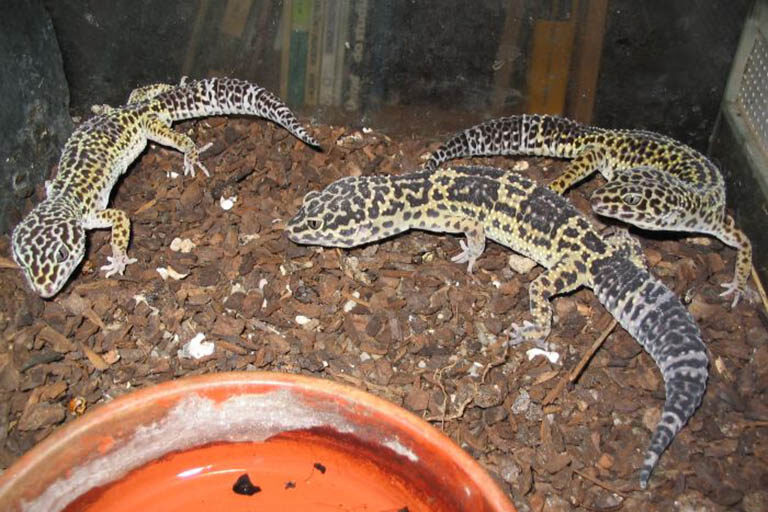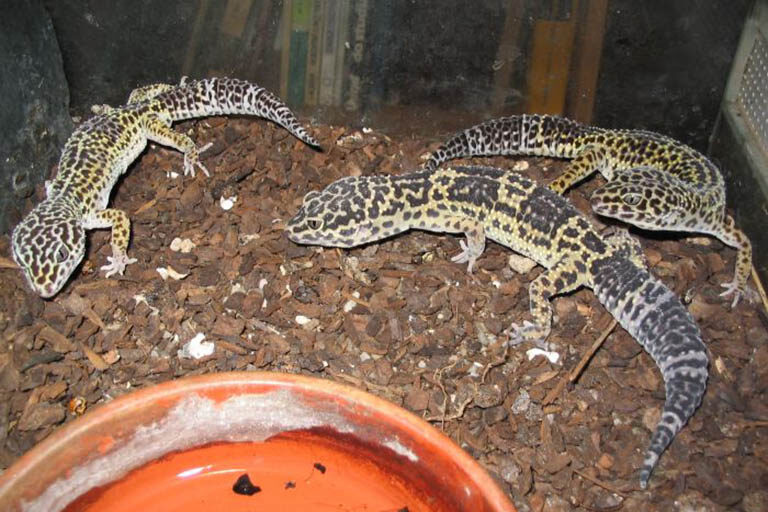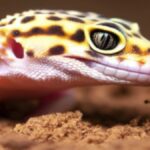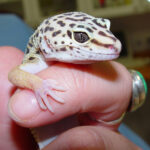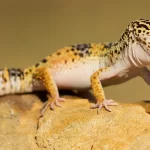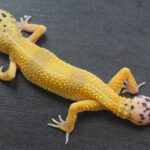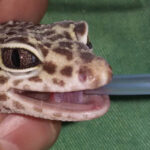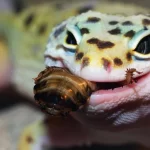Glass climbing in Leopard geckos is often seen by owners. A Leopard gecko climbing the glass of its enclosure is often a sign of distress.
Introduction to Leopard gecko glass climbing
Glass climbing in Leopard geckos is when a Leopard gecko is continually trying to climb the glass surfaces of the enclosure and slips off again. Sometimes Leopard geckos will also try to climb non-glass surfaces.
Leopard gecko glass climbing is often the result of some sort of distress and is an attempt to escape (author’s personal observation).
Glass surfing behaviour
Glass climbing in Leopard geckos is also referred to as ‘surfing’ because when the Leopard gecko keeps sliding off, it will fall and move to one side and then try to climb that area again, and so forth. This will lead to the Leopard gecko moving from one side of the enclosure to the other side – making it look like ‘surfing’.
Common reasons for glass climbing in Leopard geckos include:
- Unfamiliar surroundings (e.g. moving to a new enclosure or new additions to an established enclosure)
- Extreme temperatures (e.g. when the temperature is too high or too low)
- Incorrect humidity (e.g. when no humidifying shelters are supplied)
- Overcrowding (e.g. when the keeping enclosure is too small)
- Over- or underfeeding (e.g. when feeder insects are roaming around or when there is not enough food)
- Lack of proper hiding areas
Unfamiliar surroundings
Leopard geckos are commonly seen showing glass climbing behaviour during the first couple of days after being introduced to a new enclosure. This is even more true in the case of baby Leopard geckos.
It is important to keep handling to a minimum during these times and only open or move the enclosure during this time when it is absolutely necessary.
Also see
Handling a Leopard gecko
Leopard geckos inhabit the arid and semi-arid territories of Afghanistan, Pakistan, Iraq, Iran, India and Nepal. Although these are considered desert areas, temperatures that are too high, and obviously too low, can cause stress in Leopard geckos and lead to subsequent glass climbing behaviour.
The recommended temperature range for Leopard geckos is 25–30 ºC / 77–86 ºF(23), which can either be kept constant or be dropped to room temperature during the evenings. Ideally, a temperature gradient should be created to allow Leopard geckos to thermoregulate.
Temperatures are measured using a thermometer.
Also see
Natural distribution of Leopard geckos
Leopard gecko thermometers
Too high temperatures
Apart from climbing behaviour, Leopard geckos that are kept in temperatures that are too high include anorexia (refusal to eat) and fast and open mouth breathing. High temperatures can also cause immunosuppression(34)(35) and even be lethal to Leopard geckos.
The obvious thing to do in cases where environmental temperatures are too high is to reduce the heat supply of the heating equipment. This can be done using a thermostat or by changing over to less powerful lighting or under tank heat mats. Also, make sure that the heat source is only emitting about a third of the floor space of the enclosure.
Too low temperatures
Low environmental temperatures are not as dangerous as high temperatures but still causes stress in Leopard geckos. Apart from climbing the glass of the enclosure, too low temperatures can also cause lethargy and anorexia.
If the required temperature range of Leopard geckos cannot be achieved naturally (e.g. living in colder parts of the world), heating equipment will be required. Nighttime temperatures should also be controlled in the case where it is monitored to be below 18 ºC / 64 ºF.
Also see
Supplying heat to Leopard geckos
Incorrect humidity
Another common reason for stress and Leopard gecko glass climbing is when the humidity of the enclosure is too low. Apart from glass climbing in Leopard geckos, low humidities will first be observed by excessive soaking behaviour and skin shedding problems.
Although Leopard geckos are from semi-desert areas, they actually prefer microhabitats where there is some moisture. These include areas with tunnels, stacked rocks, pieced of wood and plant material where they can hide
The best way to supply humidity to Leopard geckos is by adding one or more humidifying shelters. The substrates used inside these areas are wetted to be moist.
Also see
Correct humidity for Leopard geckos
Suitable substrates for Leopard geckos
Although Leopard geckos are considered gregarious(49) and naturally live in small colonies(30)(50), overcrowding can cause stress and climbing behaviour. Some breeders also prefer to house baby Leopard geckos in groups.
Overcrowding becomes a problem when the keeping enclosure is too small, different sized/aged Leopard geckos are housed together or when more than one adult male is kept in the same enclosure(50).
Harem of Leopard geckos. As Leopard geckos get older, they prefer to stay in smaller groups where there is only one male.
Enclosure size
Typically, one adult male Leopard geckos can be kept with a harem of several female Leopard geckos(50).
A single Leopard gecko can be housed in an area as small as a 10-gallon tank / 30 x 30 cm / 12 x 12 ″, but bigger is better. One or two Leopard geckos can be housed together in an ADDIS (35 x 25 x 15) cm / (13.7 x 10 x 10) ″ container with the correct setup.
A 20 gallon / 30-50 ℓ / (61 x 23 x 33) cm / (24 x 9 x 13) ″ glass tank, “Pal pen™ “or “Desert den™” can also be used to house one to a few Leopard geckos.
The floor space should increase by at least 25% for every gecko added after that.
Different sizes
As long as they are all adult, different sized/aged Leopard geckos can be housed together without problems. Housing different aged baby and juvenile Leopard geckos together can cause unfair competition for food and even bullying where the smaller ones often loose.
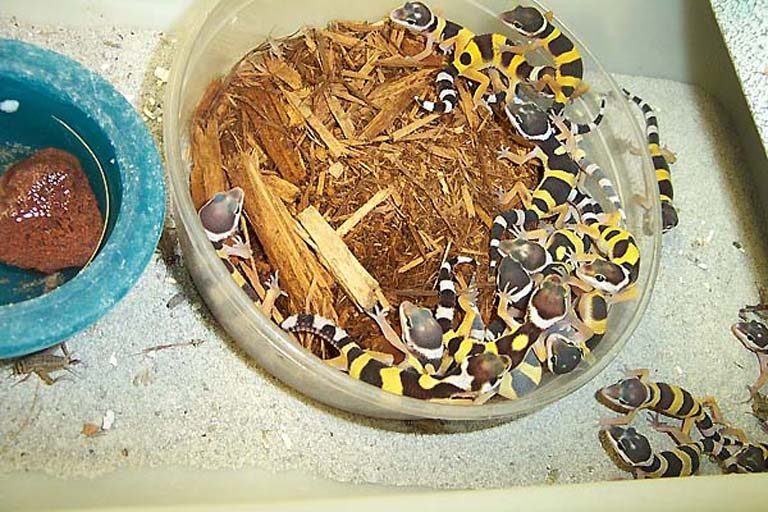
Baby Leopard geckos are often kept in groups in order to save space. When different sized baby Leopard geckos are housed together, they might stress and show climbing behaviour.
Adult males
Males will generally not tolerate each other unless juvenile(50).
Over- or underfeeding
To prevent Leopard gecko glass climbing behaviour it is important to feed the correct quantity and size of feeder insects.
Feeding too little
Leopard geckos are active hunters. When hungry, they will often go out and look for food. In the case where there is no food, Leopard gecko glass climbing behaviour might be observed in an attempt to go and look for food.
On average, Leopard geckos need to be feed every day, or at least every other day. The best feeding times is probably during the evening when Leopard geckos are mostly active.
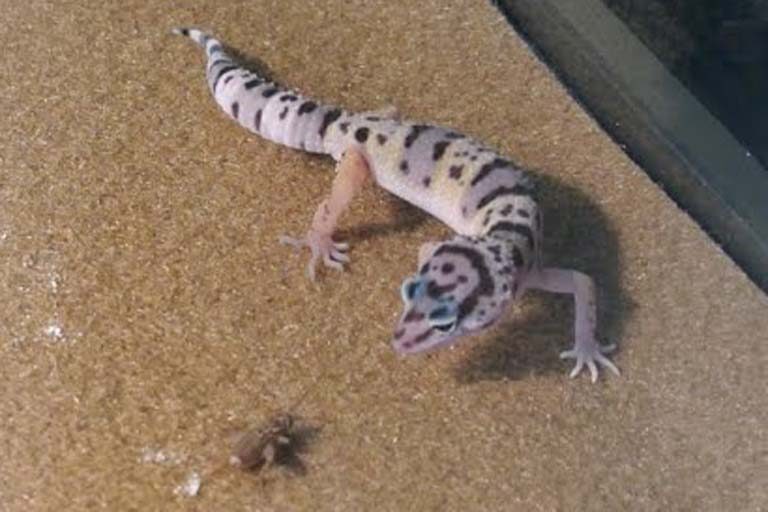
The correct prey size in moderate numbers can stimulate hunting behaviour in baby Leopard geckos. Image from YouTube.com.
Walking insects such as crickets should be offered one-by-one, or a few at a time until the Leopard gecko has lost interest. Crawling insects such as mealworms or silkworm larvae can be offered at libitum (always be available) in a small shallow escape-proof dish. Although ‘crawlies’ should always be available, they must be fresh.
Feeding too much
Similar to not eating enough, too many free-roaming food items can also cause Leopard geckos to stress and try to escape. Large food items can be intimidating or simply too strong to overpower, leading to anorexia (refusal to eat) and fear. In these cases, reducing the size and the number of feeder insects often helps.
Also see
Feeding pet Leopard geckos
Lack of hiding areas
Being crepuscular(50)(51)(59) to nocturnal(49)(69) by nature, Leopard geckos need a place to sleep and hide away during the day.
In the wild, Leopard geckos will spend a great deal of time avoiding bright light and to stay out of sight of predators(31). These times are spent under rocks, under trees and in burrows, tunnels and holes under the soil. These are also the areas where Leopard geckos will sleep and deposit their eggs. Without an adequate place to hide, Leopard geckos might start to show glass climbing behaviour.
To simulate this behaviour and create a similar environment, it is important that hiding areas are supplied(50). Hiding and sleep areas for Leopard geckos (also called shelters, hides or retreats) can be supplied in the form of hide boxes, cave-like structures and custom decorations.
Also see
Leopard gecko hide areas and hide boxes
Conclusion
Although there might be other reasons for Leopard geckos to try to escape and show glass climbing behaviour, the main factors include unfamiliar surroundings, extreme temperatures, incorrect humidity, overcrowding, over- or underfeeding and the lack of hiding areas.
These factors need to be corrected to reduce stress in Leopard geckos.

